At the beginning of the 20th Century, New Home sewing machine models sat proudly in thousands of homes in the United States. New Home competed against Singer and White but then seemed to disappear in the 1950s. If you own one of these vintage machines, you probably want to find out everything you can about New Home sewing machine models, history, and value!
The New Home Sewing Machine Company changed hands multiple times from the mid-1800s through 1954. At this point, the Japanese company Janome bought out the New Home brand and continues to sell a handful of modern machines under this name today. Older New Home models have solid craftsmanship and contain durable metal parts.
In this article, you will find out who made New Home machines in the past, as well as who makes them today. You will discover popular models of antique and vintage New Home machines. Finally, you will learn how to date your old New Home model.
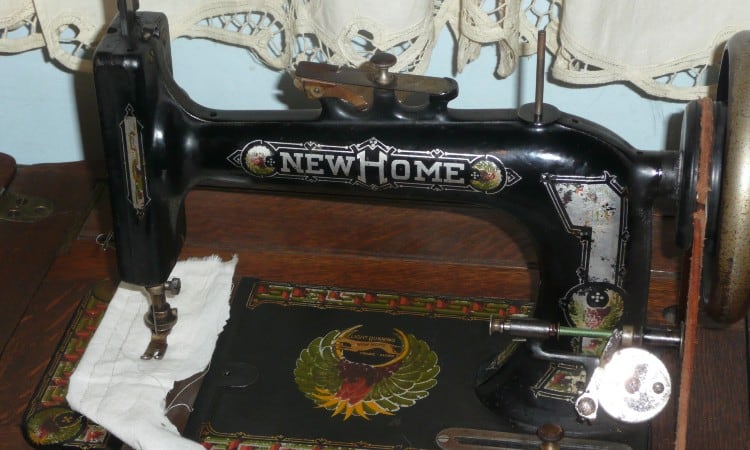
Source (1)
History of New Home Sewing Machines
The New Home Sewing Machine Company changed owners and company names many times. Despite this, the company achieved a golden era of success from 1900-1920.
In 1860 two New England men manufactured and sold their first sewing machine model, called the New England. Thomas H. White and William L. Grout decided to jump on the bandwagon of the brand new concept of manufacturing domestic sewing machines. At the time, both men had experience making furniture rather than anything mechanical.
This tiny company had three employees, including W.P. Barker, who helped sell them to local customers.
In 1861, Grout decided to strike out on his own, and White and Barker continued the sewing machine operation. The tiny operation produced a small batch of sewing machines at a time. Then Barker would use a horse and wagon to haul the machines out into the local towns and countryside to sell them.
The next section of the New Home timeline gets a bit confusing, so brace yourself!
First, White decided to move the company into larger premises and hire more employees. Despite this positive step, Barker wanted to go his own way.
Barker formed yet another sewing machine company with a man named Clark. This company launched successful models such as the Pride of the West and the New England Sewing Machine.
Meanwhile, White left his company in the hands of his sons. He moved to the midwest of the United States. There he eventually launched the White Sewing Company.
Meanwhile, Grout designed multiple sewing machine models of his own and eventually came back to New England. Grout’s inventions ultimately drove the fledgling New Home company to its success, as he personally designed several of its most popular models in later years.
But what about the New Home Company? Back in New England, Barker and Clark officially renamed their company the Gold Medal Sewing Machine Company in 1867.
The “New Home” line of sewing machines hit the market in 1870, which heralded the beginning of great success for the company.
Several men served as superintendents of the company before its first real breakthrough in 1882 when it was finally officially named the New Home Sewing Machine company. Two of the founders, Clark and Grout, once again had a hand in running everything.
New Home entered its golden era from the 1880s-1920. They manufactured hundreds of thousands of machines. A few of the popular models made during this time included the Ruby and the Little Worker.
One dark note soured this huge success in 1898 when a fire caused a catastrophic loss of revenue for a period of time. At first, the company seemed to rebound from this loss. A giant new factory emerged in 1901 and business boomed.
In fact, in 1904, New Home sold more than six million sewing machine needles in one year, a shocking number at the time! The company averaged sales of more than a hundred thousand sewing machines a year through the early years of the 20th century.
Does New Home Still Exist Today?
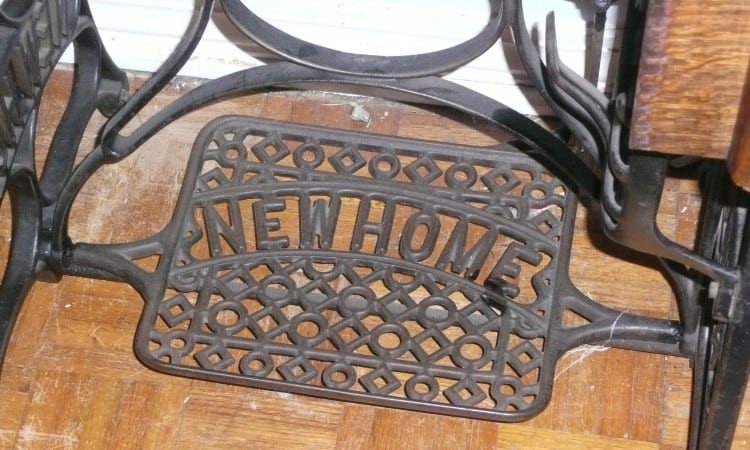
The New Home Sewing Machine Company no longer exists, though another brand still sells some sewing machines under this name.
The golden era of the New Home Sewing Machine Company came to an abrupt end in 1920 when the company tried to expand even further by purchasing all the stock of another nearby company. This backfired. New Home went into severe debt and the bank began to manage the company.
Despite several reorganizations and a parade of new managers, the New Home Company was bought out by the Free Sewing Machine Company in 1928. Mind you, production continued despite all this turnover, and New Home models remained wildly popular through the 1930s and 40s!
Is Janome the Same As New Home?
 Janome bought what remained of the New Home company in 1955 and continued to sell a few New Home models, though over time, the machines called “New Home” became more modern and had no similarities to the original New Home brand.
Janome bought what remained of the New Home company in 1955 and continued to sell a few New Home models, though over time, the machines called “New Home” became more modern and had no similarities to the original New Home brand.
The up-and-coming Japanese sewing machine company had made a name for itself in post-WWII Japan. The Japanese company sought a way to break into the American market. Buying New Home gave them a foothold in the United States.
Over time, Janome continued to market a handful of models still named “New Home,” though the New Home Sewing Machine Company ceased to exist.
Even today you can find a few Janome models marketed under the name “New Home.” These models have no similarity to the original antique and vintage New Home machines, of course!
New Home Sewing Machine Models
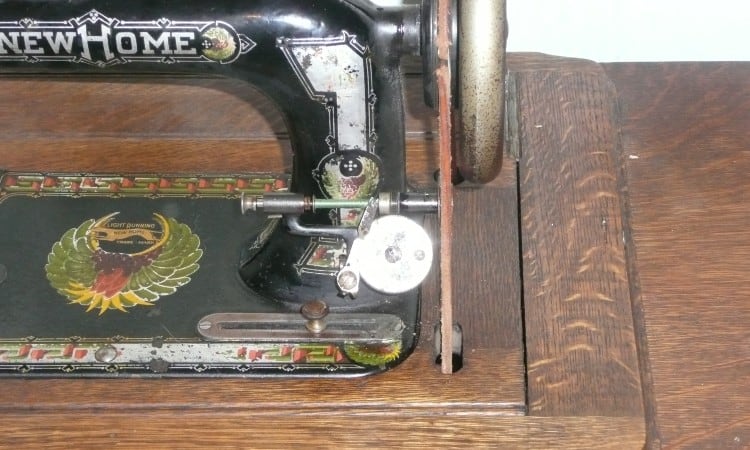
Source (1)
New Home models became most popular during the early 20th century, but the company sold hundreds of models over nearly a century. You can even still find some of the earliest models made before the company was named New Home Sewing Machine Company.
The frequently changing company ownership and company name make it difficult to track down what exactly qualifies as a “New Home” machine since many of the early models did not carry the new Home brand name.
Historians typically consider anything made by the precursors of the New Home company to belong to this brand, though. For example, the Gold Medal company was what would become the New Home company, so Gold Medal machines are sort of New Home machines, too!
Antique Models
Any sewing machines made before the 20th century typically get termed “antique” rather than vintage. Most of these machines did not use electric power. Instead, they operated by either hand crank or treadle.
As you now know, White, Grout, and Baker called their seminal model the New England. This tiny tabletop machine had a hand crank to drive the needle up and down.
The upside-down “C” shaped Gold Medal chain stitch machine also had a brief run of popularity during this time.
As mentioned earlier, the Little Worker (also known as the Midget) and the Ruby models also had a lot of success in the pre-1900s.
As the company expanded, these machines gained fancy cabinets and tables. Eventually, treadle-operated models edged out the simple hand crank machines. All of the machines from this era have solid cast iron parts and weigh quite a lot!
Vintage Models
New Home machines made after 1900 but before 1960 fall into the vintage sewing machine category. These models may have a cast iron, aluminum, or even plastic body but contain solid metal inner parts.
During its heyday before the great debt of 1928, New Home produced hundreds of thousands of machines and many models. A few of the most popular pre-1930 models include:
- The New Home A1 and A2. These models had a cast-iron body, elaborate gold leaf decoration, and a vibrating shuttle.
- The New Home Oscillator, made from advancing sewing machine technology in the 20th century. This model had a central bobbin. It also has a special diamond decal located near the stitch length control.
- The New Home New Ideal stands out because of its narrow shank shuttle. It also has a vibrating shuttle and a round needle bar.
- New Home No. 30 hit the markets a bit farther into the 20th century and operated under electric power. It still had a vibrating shuttle, though.
Modern Models
 After Janome bought out what remained of New Home in the 1950s, the Japanese company briefly continued to sell existing New Home Models. For this reason, you can find vintage, authentic New Home models through the 1950s.
After Janome bought out what remained of New Home in the 1950s, the Japanese company briefly continued to sell existing New Home Models. For this reason, you can find vintage, authentic New Home models through the 1950s.
At some point, though, Janome began to make the New Home machines. The Japanese company continues to produce a few machines under the brand name New Home logo even today.
Janome has a great reputation in the sewing machine world. You can count on getting quality when you purchase a Janome model, whether it bears the Janome name or the New Home name! That said, modern New Home models have nothing in common with the original vintage New Home machines.
For example, the very cute, quaintly colored New Home Derby line produced by Janome today offers ten stitch settings, a bright plastic body, and minimal weight of only five pounds! This travel sewing machine offers beginners and kids a fun option to learn basic sewing.
The Janome New Home 7700, in contrast, is a computerized model for advanced quilters and sewers that has a price tag of almost $3,000! This machine has all kinds of bells and whistles, including hundreds of stitch settings and a special computerized Accufeed system to stitch through thick quilts.
New Home Sewing Machine Serial Number
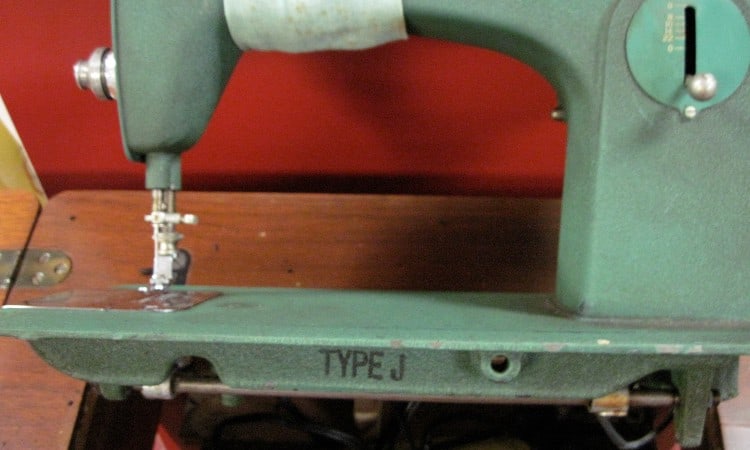
Source (1)
If you want to find out when your New Home machine was made, you need to start by finding the serial number! Most New Home machines made in the early 20th Century have a side plate engraved with this serial number.
On some older models, you might find the plate attached to the back of the machine instead, beneath the handwheel.
Now, if you’re looking at a truly old, antique model made before the turn of the 20th century, you may need to go off the logo painted onto the machine and identifiable characteristics found in its design. These old models did not all have serial numbers.
Starting in 1930, New Home models acquired a letter designation as well as a serial number. Every model had a letter assigned to it such as AC, TS, or the US.
If you can find the serial number, you can proceed in several different ways to identify your machine.
First, you can check out this website and see if you can match your number to the production year or model letter. This list does not include all of the antique and vintage New Home serial numbers, though.
You can also try Janome’s list of retired models or contact Janome through the company’s website to ask for more information.
Finally, and perhaps most helpful, you can seek out online sewing forums to see if any other sewing enthusiasts have posted about vintage New Home sewing machines. You can often share a picture of your machine, and other sewers will respond with helpful information!
New Home Sewing Machine Value
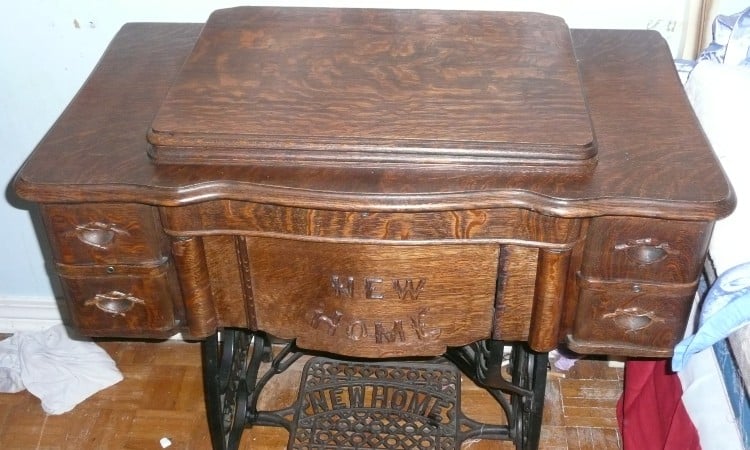
Source (1)
Older New Home sewing machines typically sell for between $100-$300. Antique and vintage sewing machines rarely have a high price tag, and New Home models are no exceptions.
Even really old Gold Medal models don’t have much of a collector’s market, meaning that if you find them on eBay, they won’t cost a lot despite their age!
The good news is that if you would like to purchase a vintage New Home model, you can almost always find a handful for sale online. Check eBay and Etsy for these frequent listings! Of course, you can also browse local antique or thrift stores.
New Home produced so many models before 1950 that you can still find quite a few floating around for sale today!
The bad news is that old sewing machines do not fit the bill if you want something highly collectible that will hold its value. People tend to value vintage sewing machines for actual use rather than resale value.
If you want to buy a New Home machine to use, make sure you find a model with no obvious blemishes. If possible, ask to see it operated, so you know it still runs.
Sometimes sellers will offer the assurance that a certified technician cleaned and repaired the vintage machine. These vintage models may cost a bit more, but they also give you much more certainty about the state of the machine.
New Home Sewing Machine Manual
Locating a New Home sewing machine manual will give you crucial information about cleaning and running your machine. Unfortunately, finding this instruction booklet for some of the older models will prove challenging.
Your best option for finding a free manual is probably to post on an online sewing forum and ask if any other sewers have a manual they could share as a PDF. The sewing community has a welcoming, collegial air and you will find that sewers really like to help each other!
You can also search eBay and Amazon for hard copies of old manuals to see if you can find one for sale.
The International Sewing Machine Collectors Society often provides a deep well of information about all things vintage sewing, but in this case, they have very little to offer. You can try this website for more antique instructions or search Sew USA for a more extensive list of manuals that you have to purchase.
How to Thread a New Home Sewing Machine
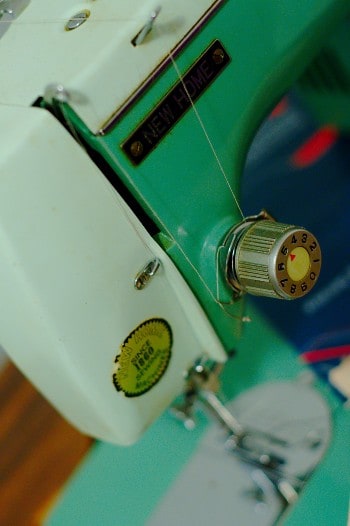
Source (1)
Learning how to thread your vintage New Home sewing model is an essential step in actually using your machine!
Modern sewing machines often share a fairly similar threading mechanism, but vintage machines may vary in the thread path. For that reason, you need the manual to learn how to thread your particular model of New Home machine!
Alternatively, you can always search youtube to see if anyone has posted a video demonstrating how to thread the type of machine you own.
That said, these instructions give you the basic steps for threading a treadle New Home model.
- Slot your thread onto the spool pin located on the top left of the machine.
- Unwind about two feet of thread, and hold the loose end of the thread.
- You will see a small metal tongue sticking out on the top right of the machine. Pass the thread beneath this thread guide.
- Next, continuing to follow the thread path from left to right across the top of the machine, thread the loose end through the hole in the small metal nub sticking up at the very front of the machine. This is the top of the needle bar.
- You will now need to drape the loose end of the thread over the groove in the front of the machine. Nothing really holds it in place here aside from the depression in the metal.
- At the bottom of the machine front, you will find a metal hook. Slot the thread through this hook. This is the take-up lever.
- Thread the needle left to right.
- Turn the handwheel to make sure the thread pulls through easily as the needle rises and falls!
The only tricky part of this process is getting the thread looped in the take-up hook correctly. You may want to find a visual of this in your manual to make sure you do it right.
It’s also worth noting that you have to accustom yourself to seeing the thread lie on the outside and front of the machine, rather than wrapping through an internal thread path through tension discs as it does in modern machines!
Which Type of Sewing Machine is Best for Home Use?
 The best sewing machine for home use depends on your sewing skill and the kinds of sewing you plan to do. Beginning sewers often prefer an economy machine that offers the basics without costing an arm and a leg. In contrast, highly advanced sewers may require quilting or embroidery machines that cost thousands of dollars.
The best sewing machine for home use depends on your sewing skill and the kinds of sewing you plan to do. Beginning sewers often prefer an economy machine that offers the basics without costing an arm and a leg. In contrast, highly advanced sewers may require quilting or embroidery machines that cost thousands of dollars.
Either way, buying from a reputable brand is a good idea. Singer, Janome, Brother and Bernina, to name just a few, offer the assurance of their solid reputations behind the craftsmanship of all their machines. These companies can provide great customer service if you run into an issue, too!
Then you find yourself facing the question of whether you should buy vintage or modern. Vintage machines do not often have the level of support you can find for a modern machine. You will find it harder to find manuals or parts for an old machine.
On the other hand, sewing machines made before 1960 contain solid metal parts that will last forever with proper care. Modern machines do not have this durability. On top of this, modern machines cannot always sew through tough fabric because of their cheap plastic parts.
Indeed, vintage machines do not provide as many features as a modern machine, but many of them can do straight and zigzag stitch, the basic components you need for sewing any type of clothing!
Would a vintage or modern New Home sewing machine meet your needs? Vintage New Home models have a solid reputation for durability, though they do not have the collectibility or customer support you can often find for old Singer models.
Janome’s modern New Home models will bring you lots of excellent customer support. That said, they don’t necessarily stand out in comparison to high-end brands like Bernina.
The bottom line is that if you want a basic sewing machine for simple tasks at home, most big-name brands can provide a simple machine at a low cost to meet your needs. You will not find a huge level of difference from one economic model to another.
You may also want to consider mastering how to use a basic vintage model for this kind of sewing. This investment of time will more than pay for itself because your vintage model will last forever and not require frequent replacement like most modern economy models.
If you’re a highly advanced sewer looking for a specialized machine, you may want to look for a high-end brand that offers fancy computerized sewing machines. In this case, New Home models are not for you!
Conclusion
The New Home Sewing Machine Company changed ownership and company name multiple times between 1860 and 1950. Despite this, the company saw huge success during the early 20th century and produced hundreds of thousands of sewing machines. In the 1950s, Janome bought New Home and continues to sell a line of New Home models today.
Vintage New Home machines offer solid metal workmanship and great durability. That said, they do not have great collectibility and will not sell for a high price. Finding sewing machine manuals, replacement parts, and information about older New Home models may present a challenge as well.
Do you own a New Home machine? How old is it? Leave a comment below to let us know!
(1) Shared under a Creative Commons (BY-SA) license
Randy Kroeger
Monday 10th of April 2023
I have my grandmother's from about circa 1926/1927 Series B, treadle. I bought machine needles for the machine in the 1970s when I was a kid and had brochures on models of that time, in which I kept. Still have the address where the needles were sent from at that time. It was a New Jersey address. At that time, I could only get two different sizes of needles for that machine. It was between 1973 and 1975... I was a kid learning to sew on my grandmother's treadle.